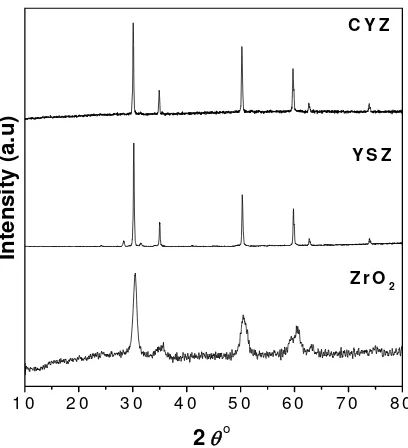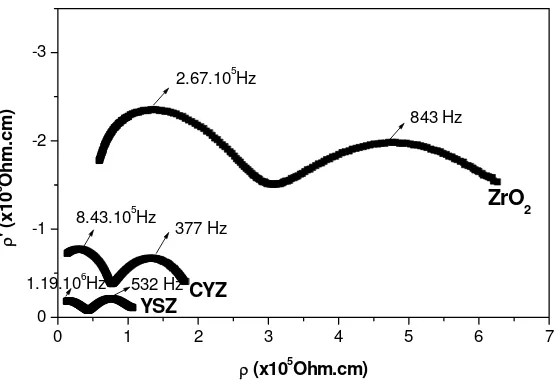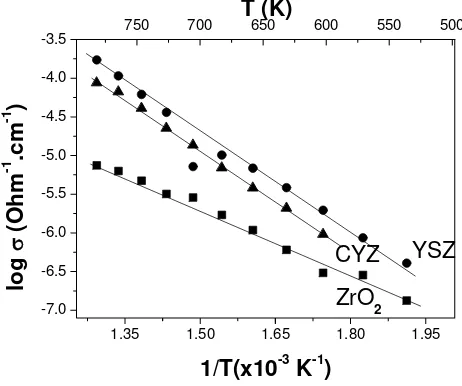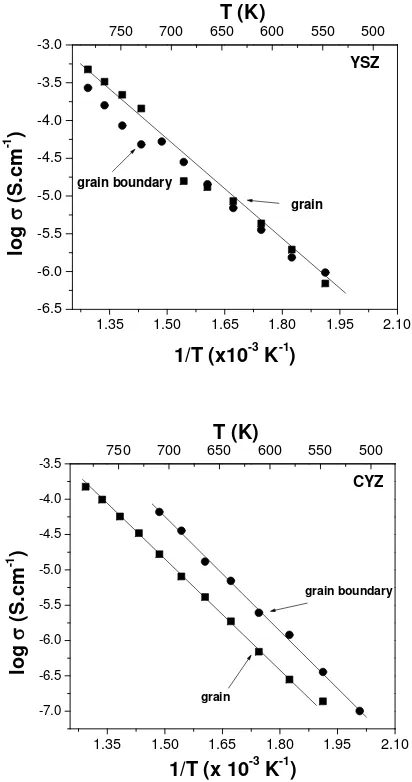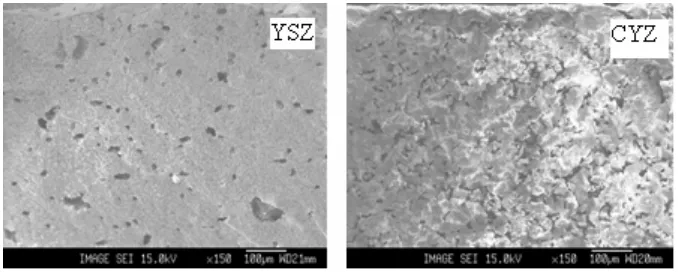Doping Calcia and Yttria into Zirconia Obtained from by
Product of Tin Concentrator to Improve its Ionic
Conductivity
Fitria Rahmawati1, Bambang Prijamboedi1,Syoni Soepriyanto2 & Ismunandar1
1Inorganic and Physical Chemistry Research Group, Faculty of Mathematics and
Natural Sciences, Institut Teknologi Bandung, Jl. Ganesha 10 Bandung 40132
2Department of Metallurgical Engineering, Faculty of Mining and Petroleum
Engineering, Institut Teknologi Bandung, Jl. Ganesha 10 Bandung 40132 Email: [email protected]
Abstract. Zirconia has been prepared from Zircon concentrate by caustic fusion
methods. Zircon is a by product from tin ore concentration plant at Bangka island of Indonesia. Yttria Stabilized-Zirconia (YSZ) was prepared by introducing the 8 % mol yttrium oxide into zirconia and sintered at 1500 C for 5 hours. In order to obtain constant oxygen vacancy of 8 % mol in Zirconia, an appropriate amount of Yttria and Calcia were introduced into Zirconia and the mixtures were heated at 1350 oC for 5 hours. Elemental composition was determined by SEM/EDX and XRF and lattice parameters were determined using X-ray diffraction method. Ionic conductivity was measured by complex impedance spectroscopy. The results show that doping of Yttria into Zirconia (YSZ) and Calcia-Yttria into Zirconia (CYZ) allows phase transformation of Zirconia from tetragonal with space group P42/nmc into cubic Fm3m and enhance the ionic conductivity. However, the prepared materials are porous and have not met the requirement for the electrolyte material yet.
Keywords: electrolyte material; CYZ; SOFC; YSZ; zircon.
1
Introduction
Yttria Stabilized- Zirconia (YSZ) is widely used as the electrolyte for solid oxide fuel cell (SOFCs) since it exhibits sufficient ionic conductivity at operating temperature as high as 1000 oC [1]. However, a considerable interest in the mixed dopant effect on the ionic conductivity in several ternary systems containing ZrO2 and Y2O3 [2-4] has arisen. Some authors [5-7] found that partial replacement of Y2O3 by CaO in the system of ZrO2-Y2O3 may enhance the ionic conductivity at higher temperature (> 1127 °C). Even at the operating temperature around 1000 oC, the mixed CaO/Y
2O3-stabilized ZrO2 (CYZ) also exhibits ionic conductivity comparable to that of YSZ. Thus the ternary system ZrO2-Y2O3-CaO might be more attractive than other ternary systems, due to the lower cost of CaO compared to other trivalent oxides such as Sc2O3 and Yb2O3. Gong et al. [8] found that the migration energy, Em, and dissociation energy, Ea,
for CYZ are higher than those for YSZ but lower than those for calcia stabilized zirconia (CSZ). At temperature over than 700 °C, the conductivity of CYZ increases more rapidly than that of YSZ. It has been noted by Gong et al. [8]
that the pre-exponential factor of CYZ, ln σo, is 19.65 S cm-1 at 600-800 K, meanwhile the pre-exponential factor of YSZ is 16.84 S cm-1 at the same temperature. The high pre-exponential factor of CYZ mainly due to its higher oxygen vacancies concentration compared to YSZ.
Bucko, et al. [9] synthesized CYZ using hydrothermal method from
co-precipitated zirconia hydrogels and found that samples with 8 % mol oxygen vacancies, obtained from substitution of Calcium and Yttrium with ratio below 50:50, were composed of the cubic phase only. This cubic phase can be obtained with heat treatment at 1300 °C. This is exceptional, since based on binary phase diagram of Y2O3-ZrO2, the fully cubic phase of Y8SZ ( 8 % mol of Y2O3 doping into ZrO2) could only be achieved at heating temperature more than 1500 °C [10]. It has been found also by Bucko, et al. [9] that the
substitution of Calcia (CaO) for Yttria (Y2O3) as well as Yttria for Calcia in the Zirconia solid solutions results in an enhancement of ionic conductivity. In 8 % mol oxygen vacancy of CYZ where the ratio of CaO:Y2O3 is 10:90 (8C10Y90), introduction of Calcia produced the maximum enhancement of bulk and grain boundary conductivity.
In this paper, two types of doped-Zirconia, Y2O3-ZrO2 (YSZ) and CaO-Y2O3 -ZrO2 (CYZ), were prepared using solid state reaction method. The Zirconia was prepared by caustic fusion of ZrSiO4, a side product of Tin Mining in Bangka Island, Indonesia. This study also aims to increase value of this ZrSiO4.
2
Experimental
Zirconia (ZrO2) was prepared by caustic fusion of Zircon (ZrSiO4), i.e by reacting Zircon with NaOH, followed by acid leaching and precipitation of ZrO2 by addition of ammonia solution, as has been described by Soepriyanto, et al.
[11]. Doping of Y2O3 and (CaO-Y2O3) to create 8 % mol vacancy were carried out by solid state reaction, i.e. by introducing certain amounts of Yttria and Calcia-Yttria into the Zirconia powder. The mixed powder was ground and fired at 1350 °C for 5 hours for CYZ and 1500 °C for 5 hours for YSZ. The obtained powder was then pressed by Cold Isostatic Pressure at 200 MPa to form discs. The discs were then sintered at 1500 °C for 3 hours.
elemental composition analyses were performed by Scanning Electron Microscope (SEM) equipped with EDX. Elemental analysis was also carried out using X-ray fluorescent (XRF). Ionic conductivities of the samples were measured by electrochemical impedance measurement using Agilent E4980A Precision LCR meter in the frequency range of 20 Hz - 2 MHz and at temperature range of 200 °C - 500 °C. The data from impedance measurement were fitted using ZView program to define of grain resistance (Rg) and grain boundary resistance (Rgb).
3
Results and discussion
The XRD patterns of ZrO2, YSZ and CYZ are presented in Figure 1. XRD pattern of ZrO2 showed broad peaks, indicating the small size of ZrO2 particles. There is no secondary phase observed in the XRD pattern of ZrO2. Doping of Yttria and Calcia-Yttria into ZrO2 allow to enhance the crystallinity of material, as evident from the sharp peaks observed in XRD patterns of YSZ and CYZ. Secondary phase were found in YSZ sample and it were identified as different structure of crystal, the peaks at 28.312° and 31.624°. Meanwhile, in sample of CYZ (with 10:90 weight ratio of Calcia and Yttria), there is no indication of the presence of second phase, eventhough the sintering temperature of this CYZ is only at 1350 °C, which is lower than sintering temperature of YSZ, 1500 °C.
Le Bail profile refinement of XRD data of ZrO2 produced by caustic fusion of ZrSiO4, proceed successfully with tetragonal system and space group of . The obtained cell parameters are listed in Table 1. The small value (below 10%) of Rp and Rwp, 2.645% and 3.011%, respectively, indicate that the good fitting was achieved. Elemental analysis using XRF showed that the ZrO
nmc P42/
2 contained 1.77% Silica and 5.76% Titania.
XRD analysis of YSZ and CYZ showed that there was phase transformation of ZrO2 from tetragonal to cubic system with introduction of Yttria and Calcia-Yttria into Zirconia. Le Bail refinement of XRD data of YSZ and CYZ could be carried out successfully with cubic structure and Fm3m space group. Cells
1 0 2 0 3 0 4 0 5 0 6 0 7 0 8 0
Figure 1 XRD patterns of ZrO2 prepared from caustic fusion of ZrSiO4, YSZ (8
% mol of Yttria) and CYZ (8 % mol of vacancy).
Table 1 Cell parameters of ZrO2, YSZ and CYZ as determined using Le Bail
method.
a b
Figure 2 SEM photographs of (a) YSZ and (b) CYZ.
0 1 2 3 4 5 6 7
0 -1 -2 -3
1.19.106Hz 532 Hz 8.43.105Hz
377 Hz 2.67.105Hz
843 Hz
ZrO2
CYZ YSZ
ρ
' (
x10
5 Ohm
.cm
)
ρ (x105Ohm.cm)
Figure 3 Impedance spectra of YSZ, CYZ and ZrO2 at 350oC, frequency is
expressed in Hertz (Hz).
doping Yttria and Calcia-Yttria into Zirconia could reduce the impedance value significantly. The impedance data could be well fitted with a series circuit model of resistor-CPE (Constant Phase Element) and resistor-capacitor. CPE itself is non ideal behavior of the double layer capacitor on real cells. This model component represent several factors such as the porous-electrode effect associated with a distributed resistance/capacitance networks in the equivalent circuits and associated with electrode interface inhomogeneity [13].
1.35 1.50 1.65 1.80 1.95
Figure 4 Plot of total conductivity of prepared materials of ZrO2, YSZ and
CYZ.
200°C-500°C. The values of total conductivities of materials are plotted in Figure 4. Some authors found [5-7] that partial replacement of Y2O3 by CaO in the system ZrO2-Y2O3 may enhance the ionic conductivity at temperature higher than 1400 K.
1.35 1.50 1.65 1.80 1.95 2.10
-6.5
750 700 650 600 550 500
T (K)
1.35 1.50 1.65 1.80 1.95 2.10
-7.0
750 700 650 600 550 500
T (K)
Figure 5 Arrhenius plots of grain and grain boundary conductivity of YSZ and
In order to investigate the contribution of grain and grain boundary conductivity in the YSZ and CYZ, we plot the conductivities from those samples in separate figures, as shown in Figure 5. For the YSZ sample, we found that grain and grain boundary conductivity have similar values at temperature of 200 °C – 425 °C. At high temperature region, over 425 °C, it is found that grain boundary conductivity is lower than bulk or grain conductivity. Some authors [7,17] found that the grain boundary effect in YSZ based compound has been largely attributed to the existence of second phase, consisting mainly of oxides of Si, Al, Mg and Ca impurities in the grain boundary. However, the influence of grain boundary on the conductivity is small at high temperature [18]. Different behavior is observed in CYZ sample where the grain boundary conductivity is found to be larger than grain conductivity. We could add here, that the slope of grain boundary conductivity is larger than the slope of grain conductivity. Therefore there is a possibility to obtain higher conductivity of CYZ at high temperature by increasing the grain boundary conductivity, as stated by some authors [5-7].
The electrolyte material in SOFC should be dense enough so that the fuel and oxidant could not pass through the electrolyte. Water diffusion test on prepared materials and microstructure analysis by means of SEM analysis on low magnification (Figure 6) showed that the prepared materials are still porous and has not met the requirement for electrolyte material yet. Presumably Silica enrichment as stated above hinders the growth and densification of Zirconia. Better preparation method that could produce Silica free Zirconia from ZrSiO4 is needed.
Figure 6 Microstructure images of SEM analysis of YSZ and CYZ with
4
Conclusions
YSZ and CYZ prepared from ZrSiO4 concentrate could have high ionic conductivity (above 10-4 S.cm-1) at low temperature, 500 °C and has potential application in SOFC. Silica enrichment in the grain boundary decrease YSZ and CYZ conductivity. These impurities also result in porous structure of sintered prepared materials. At temperature range of 200 °C – 500 °C, the ionic conductivity of CYZ is found to be lower than YSZ due to the grain boundary effects. However, the grain boundary effects of YSZ are suppressed above 400 °C, implying that CYZ could have ionic conductivity comparable to or higher than YSZ at higher temperature.
Acknowledgements
This work was supported by Insentif Program by Ministry of Research and Technology, Indonesia, contract number 53/RT/Insentif/PPK/II/08 (February 15th, 2008) and 050/RT/D.PSIPTN/Insentif/PPK/I/2009 (January 20th, 2009). It was supported also by Riset KK ITB contract number 1501/K01.08/SPK/2009 January 30, 2009. Authors also gratefully acknowledge the help of Prof. G.M. Choi from Fuel Cell Centre, Department of Material Science and Engineering, Pohang University of Science and Technology, Pohang, South Korea.
References
[1] Xu, D., Liu, X., Wang, D., Yi, G., Gao, Y., & Zhang, D., Fabrication and Characterization of SDC-LSGM Composite Electrolytes Material in IT-SOFCs. Journal of Alloys and Compounds, 429, pp. 292-295, 2007.
[2] Corman, G.S., & Stubican, V.S., Phase Equilibria and Ionic Conductivity in the System ZrO2-Yb2O3-Y2O3, Journal of American Ceramic Society,
68, pp. 174-181,1985.
[3] Chiba, R., Ishii, T., & Yoshimura, F., Temperature Dependence of Ionic Conductivity in (1-x) ZrO2-(x-y)Sc2O3-y Yb2O3 Electrolyte Material, Solid
State Ionics, 91, pp. 249-256, 1996.
[4] Kaneko, H, Jin, F., & Taimatsu, H., Electrical Conductivity of Zirconia Stabilized with Scandia and Yttria. Journal of American Ceramic Society, 76, pp. 793-1975, 1993.
[5] Li, Y., Tang, Z.L., Zhang, Z.T., & Gong, J.H., Electrical Conductivity of Zirconia Stabilized with Yttria and Calcia, Journal of Material Science
Letter, 18, pp. 443-444, 1999.
[6] Gong,J.H., Li, Y., Tang, Z.L., & Zhang, Z.T., Ionic Conductivity in the Ternary System (ZrO2)1-0.08x-0.12y-(Y2O3)0.08x-(CaO)0.12y., Journal of
Material Science, 35, pp. 3547-3551,2000.
Solid Electrolyte. Material Science and Engineering B, 78, pp. 140-144,
2000.
[8] Gong, J., Li, Y., Tang, Z., Xie, Y., & Zhang, Z., Temperature-Dependence of the Lattice Conductivity of Mixed Calcia/Yttria-Stabilized Zirconia, Material Chemistry and Physic, 76, pp. 212-216, 2002.
[9] Bucko, M.M., Ionic Conductivity of CaO-Y2O3-ZrO2 Materials with
Constant Oxygen Vacancy Concentration, Journal of the European
Ceramic Society, 24, pp. 1305-1308, 2004.
[10] Scott, H.G., Phase Relationship in the Zirconia-Yttria System, Journal of
Material Science, 10, pp. 1527-1535, 1975.
[11] Soepriyanto, S., & Hidayat,T., Synthesis on Nanocrystalline Zirconia from by Product of Tin Processing in Proceeding International
Conference on Mathematics and Natural Sciences (ICMNS), Faculty of Mathematics and Natural Sciences,Institute Teknologi Bandung, pp. 460-464, 2006.
[12] Martin, P, Lopez, M.L., Pico, C., & Veiga, M.L., Li(4-x)/3Ti (5-2x)/3CrxO4(0≤x≤0.9) Spinels: New Negatives for Lithium Batteries, Solid
State Sciences, 9, pp. 521-526, 2007.
[13] Barsoukov, E., & Macdonald, J.R., Impedance Spectroscopy: Theory, Experiment and Applications, 2nd ed., A John Wiley & Sons, Inc., pp.
492-493, 2005.
[14] Agrawal, R.C., & Gupta, R.K., Review Superionic Solids: Composite Electrolyte Phase- an Overview, Journal of Material Science 34, pp.
1131-1162, 1999.
[15] Bucko, M.M., Some Structural Aspects Ionic Conductivity in Zirconia Stabilized by Yttria and Calcia, Materials Science-Poland, 24, pp. 39-44.
2006.
[16] Bonanos, N., Slotwinski, R.K., Steele, B.C.H., & Butler, E.P., High Ionic Conductivity in Polycrystalline Tetragonal Y2O3-ZrO2, Journal of
Material Science Letters, 3, pp. 245-248, 1984.
[17] Gong, J.H., Li, Y., Tang, Z.L., Xie, Y.S., & Zhang, Z.T., Temperature-Dependence of The Lattice Conductivity of Mixed Calcia/Yttria-Stabilized Zirconia, Material Chemistry and Physics, 76, pp. 212-216, 2002.
[18] Li, Y., Liu, M., Gong, J., Chen, Y., Tang, Z., & Zhang, Z., Grain Boundary Effect in Zirconia Stabilized with Yttria and Calcia by Electrical Measurements, Material Science and Engineering B, 103, pp.
